Looking for sketchbook challenge prompts that pack a punch? Try timed sketch sprints, one-line continuous drawing, or mix things up with a limited color palette. Immerse yourself in mixed media, create wild patterns and textures, or turn everyday objects into totally new creations. Test your skills with daily themed illustrations, express big emotions in portraits, draw from wacky angles, or even mash up nature and city scenes. If you’re itching for creative surprises, there’s plenty more where that came from.
Key Takeaways
- Try timed sketch sprints to boost observational skills and build confidence by drawing subjects quickly within a set time limit.
- Use only three to five colors in a limited palette drawing to enhance creativity and color harmony in your sketches.
- Experiment with mixed media by combining materials like ink, collage, and paint to discover unique textures and effects.
- Draw everyday objects from unusual viewpoints or angles to strengthen your understanding of perspective and composition.
- Create expressive emotion portraits focusing on facial expressions, color choices, and shading styles to convey mood and character.
Timed Sketch Sprints
When the clock is ticking and pencils are flying, that’s when timed sketch sprints really get exciting. Sketchbook practice turns into a race against the clock, making every line count.
Artists grab a timer—sometimes only 1 to 10 minutes!—and focus on a single subject or idea. It’s fast, it’s a little wild, and, yes, mistakes happen, but that’s the fun part. Instead of worrying about perfection, sketchbook practice in timed sprints lets artists experiment, act on instinct, and capture the big picture before the buzzer sounds.
Over time, all this speedy drawing turbocharges observation skills and boosts confidence. Whether doodling an octopus or a sneaker, these sprints train the brain to think and draw quickly.
Ready, set, sketch!
Limited Color Palette Drawings
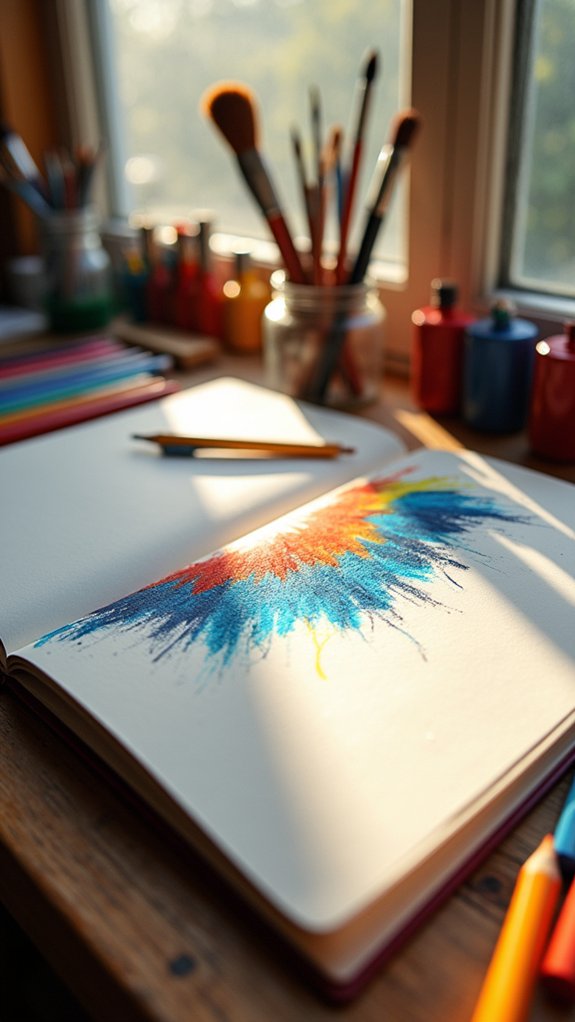
Limited color palette drawings might seem like a tough restriction, but that’s actually where the magic happens—artists get to mess around with color harmony and see how a few shades can bring a drawing to life.
When you’re only allowed, say, three colors, every choice matters, and that challenge is what pushes your creative muscles to flex hard.
It’s a bit like making a delicious pizza with just cheese, sauce, and dough—there’s nowhere to hide, but somehow, it still turns out awesome (and maybe even better than a pie loaded with too many toppings).
Exploring Color Harmony
Some artists swear by a secret weapon in their sketchbook: the limited color palette. Imagine grabbing just three to five colors and saying, “Okay, you’re all I get—let’s see what you can do!” It might sound scary, but it’s actually a genius way to explore color harmony.
By picking a handful of colors, artists get laser-focused on how colors work together. This means less time stressing over endless options and more energy for experimenting.
In art journalling, it helps your pages look super cohesive—like every drawing belongs to the same cool family. Artists get to play with different combos, like using opposites (complementary colors) or neighbors (analogous).
Focusing on limited color also makes you notice value, texture, and form way more.
Creative Constraints for Growth
Even though it might sound like a recipe for frustration, using fewer colors in a drawing is secretly one of the best ways to level up as an artist.
When your color choices are limited, you’re forced to think differently and keep your creative juices flowing. Suddenly, you’re not overwhelmed by boxes of pencils—you’re making every color count, just like a chef cooking with what’s in the fridge. Challenging? Yes. Rewarding? Absolutely.
- Focusing on just a few colors helps artists discover how colors work together, from mood to emotion—no more color chaos.
- It becomes a playground for experimenting with forms and composition, instead of just scrambling for the “perfect” shade.
- Constraints often spark the coolest, most unexpected ideas.
- Mastering limited colors can lead to a distinct personal style.
Pattern and Texture Exploration
Pattern and texture might sound like fancy art talk, but they’re really just ways to make sketches jump off the page. Pattern and texture exploration is like going on a scavenger hunt for cool marks and designs. Artists often try stamps, stencils, even leaves or fabric scraps to spice up their pages. Doodling repeating shapes or experimenting with cross-hatching isn’t just practice—it’s like giving your drawing a secret code or hidden feeling. Some artists get wild with sponges dipped in ink or make patterns inspired by ancient cultures or funky natural things, like pinecones. All this pattern and texture exploration boosts those eagle-eyed observation skills. Check out this fun table for ideas:
| Technique | Tool/Material | Inspiration |
|---|---|---|
| Cross-hatching | Pen | Tree bark |
| Stamping | Potato, stamp pad | Tribal motifs |
| Stippling | Marker | Coral reefs |
| Rubbing | Leaf, crayon | Sidewalk texture |
Daily Themed Illustrations
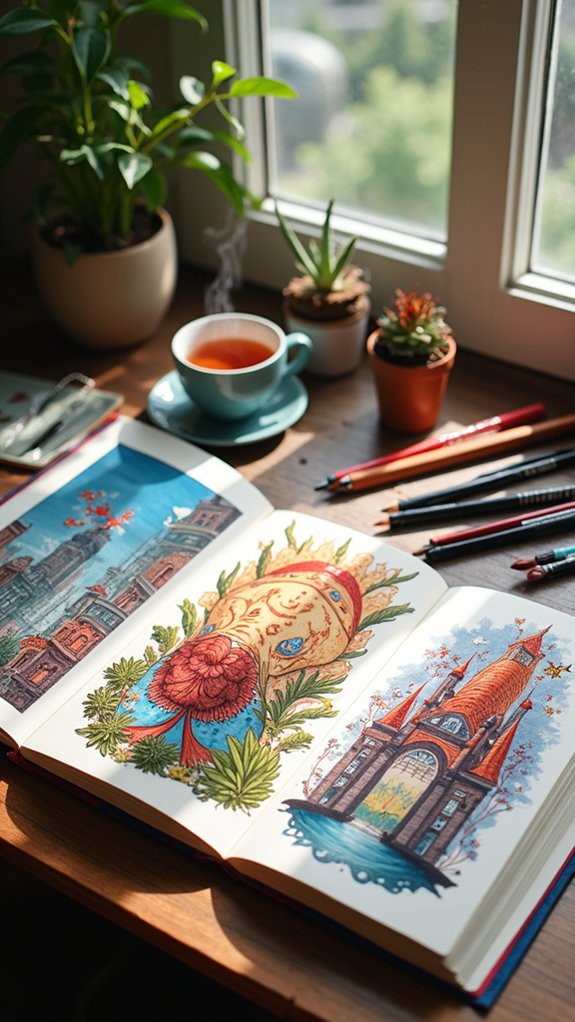
While scrolling through a list of daily themes, any artist might feel a thrill of possibility—they get to wake up, turn the page, and face whatever weird, wacky, or wonderful idea that day’s prompt throws at them.
Daily themed illustrations keep the Sketchbook Challenge fresh and exciting, pushing artists to explore new subjects in their art journal every single day. From drawing a spoon with personality to imagining what the wind looks like, these themes give artists a chance to practice skills and let their creativity fly.
The unpredictability keeps things interesting, and every completed page feels like a victory badge.
- Prompts focus on specific topics, like emotions or everyday objects.
- Daily drawing builds artistic confidence and strong habits.
- Artists strengthen skills in color, composition, and perspective.
- Sharing work sparks feedback and new inspiration.
One-Line Continuous Drawing
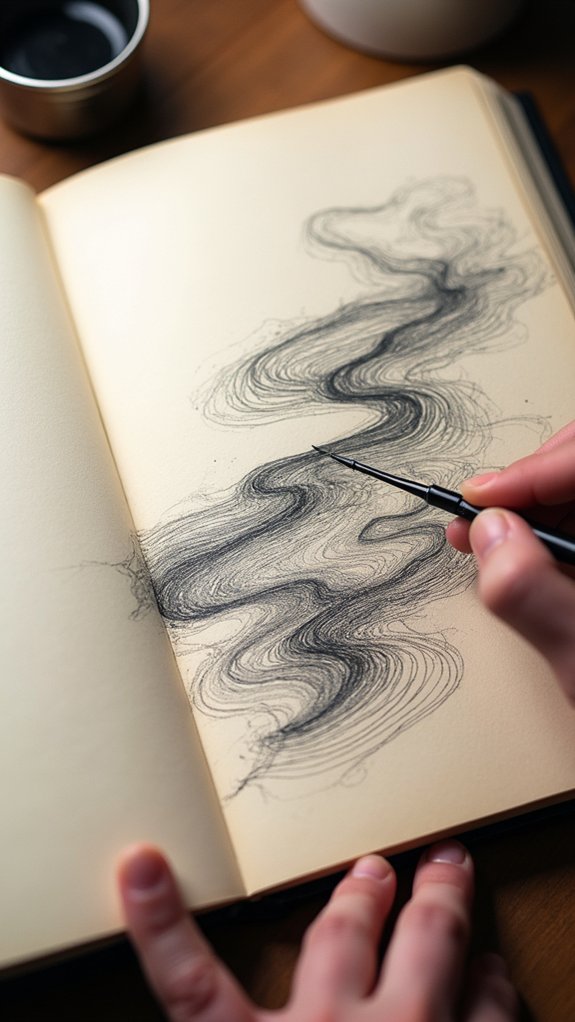
One-line continuous drawing is all about letting go of perfection and just seeing where your lines take you, even if they look a little wonky or wild.
This technique isn’t just fun—it seriously helps build your hand-eye coordination, making your eyes and hand work together like top secret agents on a mission.
As you draw, you’ll notice your brain kicking into creative focus, letting ideas flow without overthinking every single detail—plus, it’s way more exciting than erasing every “mistake!”
Embracing Imperfection in Lines
Every artist faces a moment when their wobbly lines or shaky outlines feel like mistakes, but guess what? That’s actually part of the magic. Embracing imperfection in lines can totally supercharge your drawing skills!
One-line continuous drawing is all about letting go of the need for perfect shapes and welcoming the weirdness that comes with never lifting your pen. Instead of fighting the quirks, artists can use them to make art that feels alive and full of character.
- This approach boosts creativity by helping artists see mistakes as opportunities.
- It encourages experimenting with wild ideas, without the pressure for perfect lines.
- The funky, unpredictable lines make your sketchbook way more interesting.
- Letting go of perfectionism can make drawing more relaxing—and honestly, a lot more fun!
Building Hand-Eye Coordination
Nobody said growing as an artist meant always coloring inside the lines—sometimes, it’s about stretching those lines in ways that surprise even you.
One-line continuous drawing is like a wild art roller coaster for your sketchbook—no stops allowed! You start with your pen or pencil, and once it hits the page, that’s it. No lifting up, no cheating. It sounds easy, but wow, it gives your hand-eye coordination a workout.
Artists learn to really see what they’re drawing. Some might say it’s a great book for your brain, and I’d read that any day! This technique works with a wide range of styles and even mixed media.
If you’d like to try something else, one-line art sparks tons of new ideas.
Creative Flow and Focus
If someone’s ever watched their pencil zip across the page in a single, curvy line, they’ve probably felt just how wild and freeing continuous drawing can be.
One-line continuous drawing isn’t just a quirky challenge—it’s a way for artists to unleash creative flow and laser-sharp focus. Instead of lifting the pencil, they just keep going, following shapes and chasing ideas wherever their imagination runs.
There’s something awesome about not overthinking each move—just letting the creativity lead. Artists build rhythm, mindfulness, and energy while exploring new forms.
Here’s why it matters:
- Sharpens hand-eye coordination like a secret superhero power.
- Boosts spontaneous creativity and makes perfectly imperfect art.
- Breaks down creative blocks (goodbye, blank-page fear).
- Builds confidence and connection to the drawing process.
Try it—the wild line might surprise you!
Object Transformation Challenge
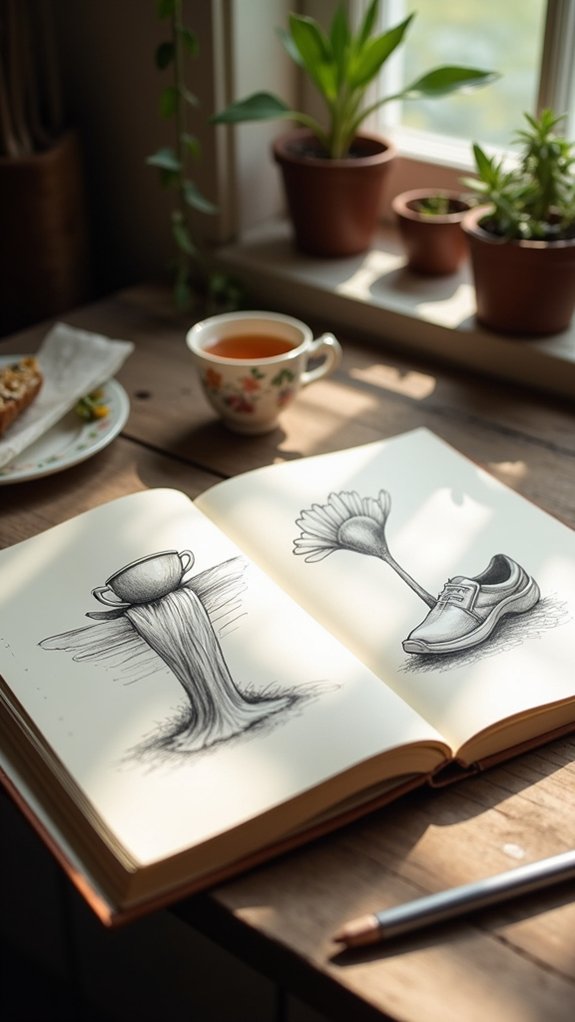
Ever wondered what happens when a toaster grows legs or a teacup decides it wants to see the world? That’s the heart of the Object Transformation Challenge.
Artists go wild, taking everyday stuff—a pencil, a shoe, a lamp—and giving it a completely new twist. Maybe your backpack bursts into song or your calculator doubles as a robot sidekick.
The trick is to notice the tiny details—those buttons, shapes, and textures—before transforming them into something mind-blowing. This challenge sparks Object Fusion, mixing objects to create fun, quirky hybrids.
Not only does it help squash creative blocks, it also boosts observation skills and storytelling through art. With every sketch, artists stretch their imagination, experiment with style, and discover surprises in the familiar.
Mixed Media Mashup
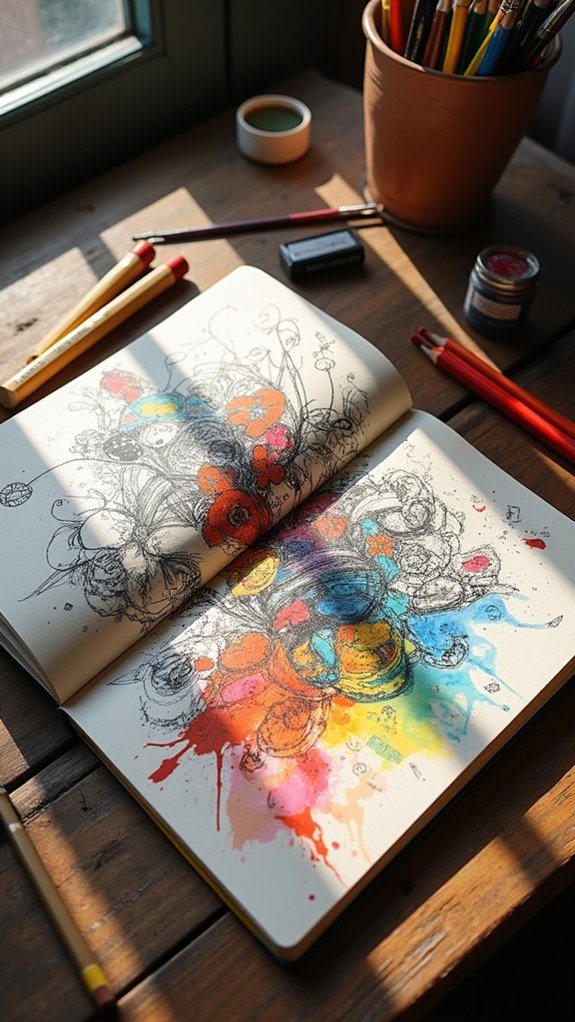
Mixing watercolor with ink, tossing in magazine clippings, or even adding a splash of fabric—mixed media mashups are like a playground for your imagination.
Curious what happens when you glue sand to a sketch or layer paint over a photo? This challenge pushes artists to mash up unexpected materials, create wild textures, and stack techniques until the page practically jumps up and shouts, “Look at me!”
Combining Different Art Materials
Grab some paint, snatch a pencil, maybe even tear up an old magazine—there’s something wildly exciting about smashing different art materials together in a sketchbook.
Combining art supplies is like throwing an art party on paper, where nobody cares if things get messy. Exploring Material Interaction means noticing how watercolor bleeds into ink lines or how pastels pop against bold acrylic backgrounds.
Don’t worry about following rules—go rogue and experiment until your page crackles with energy!
- Mix acrylic paint and collage pieces for layers that jump off the paper
- Draw with pen, then add soft washes of watercolor for dramatic effects
- Glue down textured bits like fabric or torn paper for instant dimension
- Smear oil pastel over dry painted shapes to see wild color mixes
Ready to mash up your materials?
Unexpected Texture Experiments
Sometimes, all it takes is a sprinkle of wild ideas to totally shake up a sketchbook page. Imagine gluing down sand, scraps of fabric, or even bits of broken jewelry—suddenly, you’ve made a textural collage that’s anything but boring.
Artists go beyond basic pencils and paints, using sponges, forks, or combs to create lines and patterns that make people say, “Wait, you used what?”
Nature is a great playground, too—next time you’re outside, grab a leaf or a twig and glue it in. Every time someone touches your page, it’s like an art surprise party.
Recording these unexpected texture experiments is like building your own artistic secret recipe book, so you’ll remember what worked (and what was a total mess, honestly).
Layering Techniques Exploration
After exploring all those unexpected textures, artists might feel ready to level up and get wild with layering techniques—a true mixed media mashup.
Layering isn’t just about stacking materials randomly; it’s like building a delicious sandwich, except with paint, paper, and maybe a sprinkle of glitter for good measure. Mixing up acrylics, watercolors, and a few oddball elements like fabric or pastels turns each page into an experiment.
Transparent layers work like magic windows, letting colors and shapes peek through and surprise you. Every layer can tell part of a story, which is what makes Layering Narratives so addictive.
- Use stencils or sponges for unique paint effects
- Try transparent washes to show hidden layers
- Mix in collage scraps for extra texture
- Build themes and stories as layers accumulate
Expressive Emotion Portraits
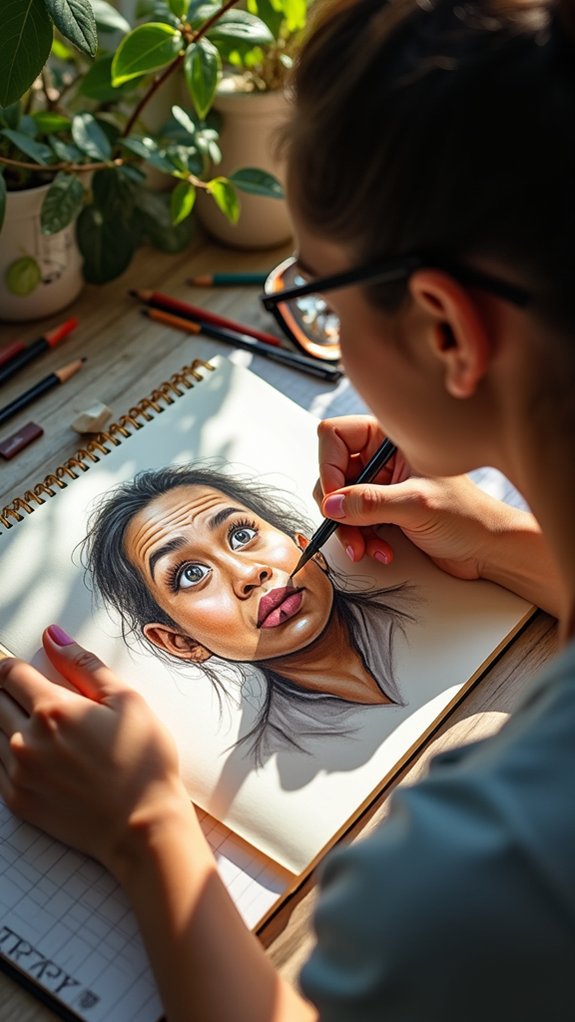
Why do some portraits make you feel like the person is about to leap right out of the paper and spill their secrets? That’s the magic of expressive emotion portraits. Artists use facial expressions, body language, and even wild color choices to bring out those deep, hidden feelings. Mastering emotion interpretation helps turn an ordinary face into a powerful story. Reference photos, try new shading styles, or toss in crazy lines—each choice changes the entire vibe. Realistic or totally abstract, it’s about diving in and seeing what feelings come out. It’s messy and amazing! Exploring a whole series lets you track your growth and discover new emotions in every sketch.
| Emotion | Visual Clue | Artistic Technique |
|---|---|---|
| Joy | Big smile | Warm, bright colors |
| Anger | Furrowed brow | Harsh, sharp lines |
| Sadness | Drooped eyes | Cool, muted tones |
Nature and Urban Mash Sketches
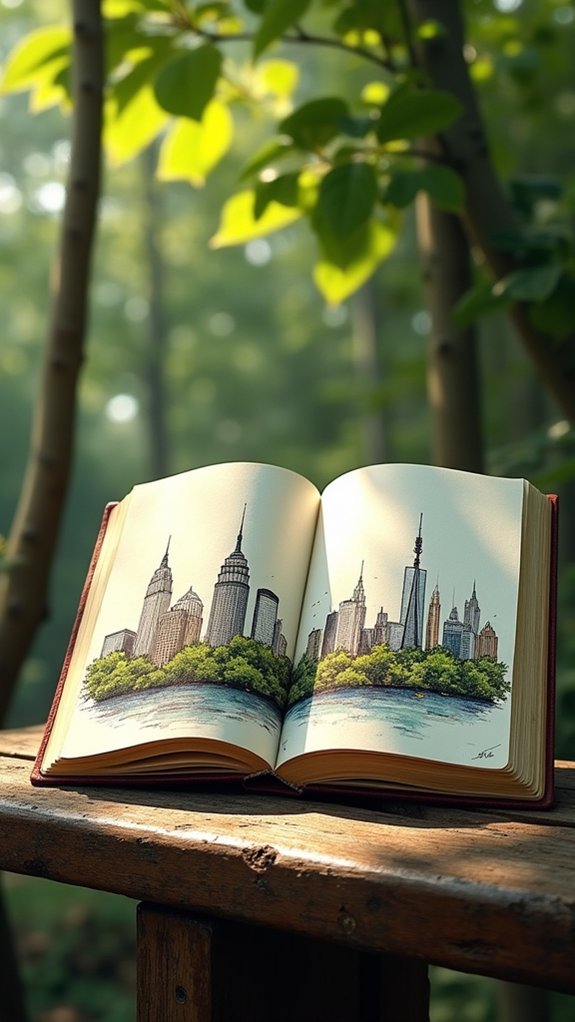
If faces can tell a wild, tangled story, just imagine what happens when trees and skyscrapers start sharing the same sketchbook page!
Nature and urban mash sketches blend the wildness of leafy branches with the neat corners of city blocks, making something totally new: Urban Wilderness. It’s like watching the forest get a cool city makeover.
Artists get to mix up textures, play with crazy contrasts, and spin stories about how nature squeezes into busy streets. Plus, it’s a hands-on way to spot details you’d usually miss.
- Mix flowing tree roots with sharp rooftops for unexpected scenes
- Turn tangled vines into subway lines or electric wires
- Capture unique light—sun filtering between brick and bark
- Show how animals and people share Urban Wilderness everyday
Sketching this way can make any notebook feel alive!
Unusual Viewpoint Perspectives
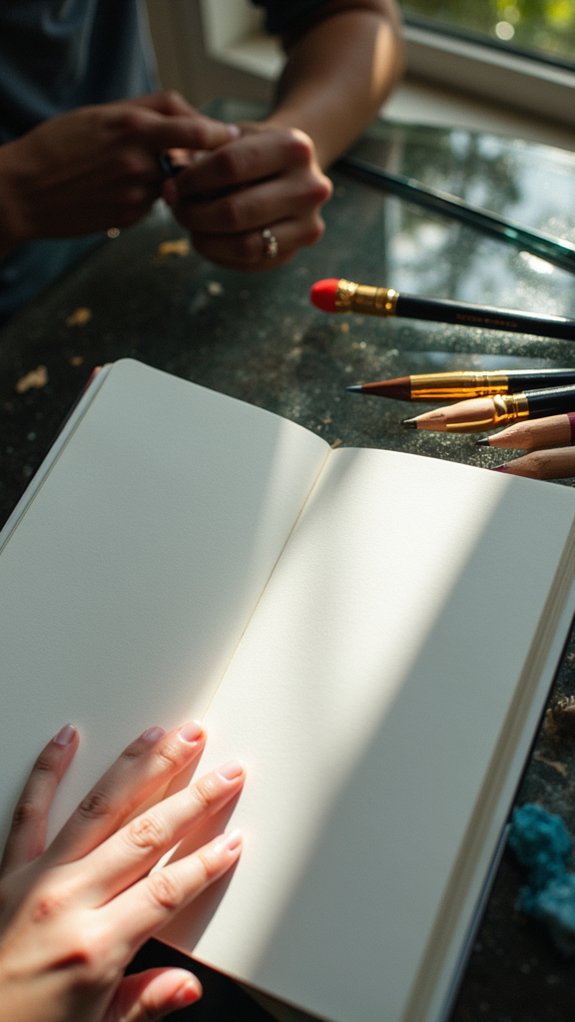
Ever wondered what the world looks like from an ant’s point of view, or maybe a superhero swooping over rooftops? Unusual Viewpoint Perspectives are all about viewing the familiar in seriously unexpected ways.
Through perspective exploration, artists challenge themselves to draw from odd angles—like peering up at towering trees or looking down from dizzying heights. It’s like giving your brain a rollercoaster ride, twisting your usual sense of space and depth!
This creative approach isn’t just cool, it makes scenes more dynamic and engaging. Artists have to think hard about foreshortening and how objects appear up-close or super far away.
Not only does this skill boost creativity, but it also sparks originality and enriches storytelling, making every sketch a little adventure.
Frequently Asked Questions
How Can I Make My GCSE Art Sketchbook Better?
To improve a GCSE art sketchbook, a student should explore diverse art techniques, experiment with various mediums, document creative processes, and seek feedback. This approach leads to a more thorough, dynamic, and thoughtfully constructed art portfolio.
What to Do for a Drawing Challenge?
For a drawing challenge, one might select daily prompts that encourage creative exploration, experiment with new styles or mediums, and share progress within an art community. Consistent participation enables artistic growth, increasing both confidence and technical skill.
How to Make Your Sketchbook Interactive?
When considering how to make a sketchbook interactive, one might add interactive elements like flaps, pockets, foldable pages, pop-ups, or QR codes. Such features transform a simple sketchbook into an engaging, multimedia, and collaborative experience.
What Is a Sketch Prompt?
A sketch prompt is a creative cue used in Sketch Prompting to inspire artistic expression. By suggesting subjects, themes, or concepts, these prompts help artists overcome creative blocks, encourage exploration, and foster consistent practice and skill development.
Conclusion
Taking on these sketchbook challenges isn’t just about improving drawing skills—it’s an adventure. Every prompt is a bit like a secret mission for your creativity. There might be some messy lines or weird mistakes along the way, but that’s part of the fun. With each challenge, artists find new ideas and maybe even surprise themselves. So, grab your sketchbook, toss perfection out the window, and let your art skills level up, one wild page at a time!

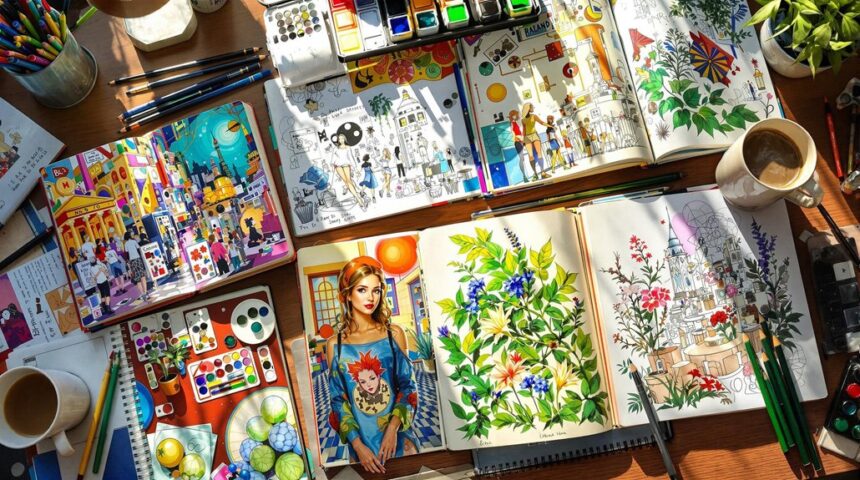
Leave a Reply